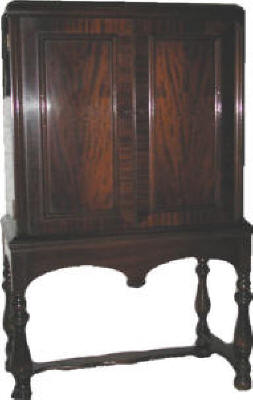
The Victor-Victrola Page
 Tuscany
(VE 12-12)
Tuscany
(VE 12-12)
RARITY: ¤¤¤¤ VALUE: ¤¤

 The
Tuscany (also called the VE 12-12) was one of the very first
mass-produced fully electronic phonographs, pairing a Victor-designed turntable
and tonearm with an RCA-built amplifier and cone speaker. It was introduced in
early 1926, and production was discontinued late that year. However, the
remaining stock of machines continued to be sold by Victor dealers well into
1927. The
cabinet used a mahogany veneer with a blended-stain effect. This instrument did
not include a radio.
The
Tuscany (also called the VE 12-12) was one of the very first
mass-produced fully electronic phonographs, pairing a Victor-designed turntable
and tonearm with an RCA-built amplifier and cone speaker. It was introduced in
early 1926, and production was discontinued late that year. However, the
remaining stock of machines continued to be sold by Victor dealers well into
1927. The
cabinet used a mahogany veneer with a blended-stain effect. This instrument did
not include a radio.
The Tuscany was an "upscale" version of its sister model, the
Cromwell, providing a higher-power amplifier and a slightly larger, more
elegant cabinet. It sold for $550.00 when first introduced (equating to about $8,000.00
in today's money), but the price was substantially cut late in the year
when manufacturing costs began to drop as a result of improved production
efficiencies for electronic components. In addition, these pioneering electronic
machines became obsolete quite rapidly, as new models with significantly
improved function were being released almost monthly during this time. Many of
the earliest electronic sets were also prone to reliability problems as well as
excessive distortion and/or hum, so not all buyers were interested in adopting
this new technology in 1926. The Cromwell was also one of the very first sets
for home use that featured a paper-cone speaker; prior to this, electromagnetic
drivers were used in the neck of large horns to provide the audio output.
Approximately 1,700 Tuscany phonographs were produced, making it a relatively
rare model. However, the high cost of restoration of these early electronic sets
limits the interest of many collectors today.
The current survival database shows the earliest existent Tuscany to be S/N 502 and the latest to be S/N 1493.
Do you own a Victor Tuscany? Please take a moment and enter some basic information about your machine into the collector's database by clicking here. No personal information is required.